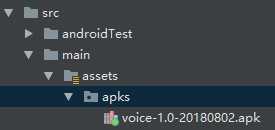标签:自启 sdi trace 好的 inter [] evel 访问权限 数据
【apk静默安装】是android应用的一个重要功能,一般用在app自动更新等方面。静默安装在android里面是指不需要界面或用户参与的app安装动作,且需要系统已获root权限。安装完成后一般通过接收广播的方式启动App服务。
【app自启动】是常用功能,一般通过接收系统启动广播实现。
a. 自定义权限
<permission
android:name="app.permission.install"
android:protectionLevel="normal">
</permission>其中android:name是自定义权限名称,android:protectionLevel是表示权限等级。
自定义权限android:protectionLevel有四个设置选项分别是:normal、dangerous、signature、signatureOrSystem,依次指明默认的低风险权限等级、涉及用户私有数据或系统级别组件的高风险权限等级、统一签名权限等级、系统级签名权限等级。此处用默认权限。
b. service标签加入权限限制(执行端必须拥有该权限才能访问)
<service
android:name=".×××Service"
android:enabled="true"
android:exported="true"
android:permission="app.permission.install">
<intent-filter>
<action android:name="×××.×××"/>
</intent-filter>
</service><uses-permission android:name="app.permission.install"/>
<receiver android:name=".Broadcast.SilenceInstallReceiver"
android:enabled="true"
android:exported="true">
<intent-filter>
<action android:name="android.intent.action.PACKAGE_ADDED"/>
<data android:scheme="package"/>
</intent-filter>
</receiver>广播接收器:
public class SilenceInstallReceiver2 extends BroadcastReceiver {
@Override
public void onReceive(Context context, Intent intent) {
// 接收安装广播
if (intent.getAction().equals("android.intent.action.PACKAGE_ADDED")) {
startApp(context);
}
}
/**
* 启动app
*/
public void startApp(Context context) {
/**
* 启动service
*/
Intent intent1 = new Intent();
intent1.setPackage("×××.×××"); //设置被执行启动操作app包名
intent1.setAction("×××.×××"); //设置被执行启动操作app中service的自定义intent
context.startService(intent1);
/**
* 启动activity
*/
Intent intent2= new Intent();
ComponentName componentName = new ComponentName(
"×××.×××", //被执行启动操作app的包名
"×××.×××"); //被执行启动操作app的activity包路径
intent2.setFlags(Intent.FLAG_ACTIVITY_NEW_TASK);//
intent2.setComponent(componentName);
context.startActivity(intent2);
}
}项目中apk存储位置:

具体代码:
/**
* 将assets下的需要安装的apk文件复制到本地可读写目录
*/
public List<String> extractApkToLocal() {
List<String> apkListLocal = new ArrayList<>();
InputStream is = null;
FileOutputStream fos = null;
String[] files;
String assetsDir = "apks";
String localPath;
try {
File file = new File(apkPath);
FileUtils.createOrExistsDir(file);
files = mContext.getAssets().list(assetsDir);
for (String f : files) {
is = getAssets().open(assetsDir + "/" + f);
localPath = apkPath + "/" + f;
apkListLocal.add(localPath);
fos = new FileOutputStream(new File(localPath));
byte[] temp = new byte[1024];
int i = 0;
while ((i = is.read(temp)) > 0) {
fos.write(temp, 0, i);
}
}
} catch (IOException e) {
e.printStackTrace();
} finally {
if (is != null) {
try {
is.close();
} catch (IOException e) {
e.printStackTrace();
}
}
if (fos != null) {
try {
fos.close();
} catch (IOException e) {
e.printStackTrace();
}
}
}
return apkListLocal;
}具体代码:
public boolean slientInstall() {
List<String> apkList;
apkList = extractApkToLocal(); //获取apk本地路径
boolean result = false;
for (String path : apkList) {
File file = new File(path);
Process process = null;
OutputStream out = null;
if (file.exists()) {
try {
process = Runtime.getRuntime().exec("su");
out = process.getOutputStream();
DataOutputStream dataOutputStream = new DataOutputStream(out);
// 更改本地apk文件权限,方便执行安装操作
dataOutputStream.writeBytes("chmod 777 " + file.getPath()
+ "\n");
// 进行安装
dataOutputStream.writeBytes("LD_LIBRARY_PATH=/vendor/lib:/system/lib pm install -r "
+ file.getPath());
dataOutputStream.flush();
dataOutputStream.close();
out.close();
int value = process.waitFor();
// 成功
if (value == 0) {
result = true;
// 失败
} else if (value == 1) {
result = false;
// 未知情况
} else {
result = false;
}
} catch (IOException e) {
e.printStackTrace();
} catch (InterruptedException e) {
e.printStackTrace();
}
if (!result) {
result = true;
}
}
return result;
}<uses-permission android:name="android.permission.RECEIVE_BOOT_COMPLETED"/>
<receiver
android:name=".Broadcast.BootReceiver"
android:enabled="true">
<intent-filter>
<!-- 这是开机启动发送的广播意图-->
<action android:name="android.intent.action.BOOT_COMPLETED"/>
</intent-filter>
</receiver>广播接收器:
public class BootReceiver extends BroadcastReceiver {
@Override
public void onReceive(Context context, Intent intent) {
Log.e("BootReceiver:", "收到开机广播");
//开启服务
Intent startVoiceService = new Intent(context, ×××.class);
context.startService(startVoiceService);
}
}静默安装有它的局限性,需要通过系统的超级用户(root)进行操作任务,所以对系统安全性不高的情况有较强的实用性。此文是在查询各方面资料基础上实现的,旨在抛砖引玉,希望集思广益后有更好的实现方案!
标签:自启 sdi trace 好的 inter [] evel 访问权限 数据
原文地址:https://www.cnblogs.com/chanfee/p/9409217.html